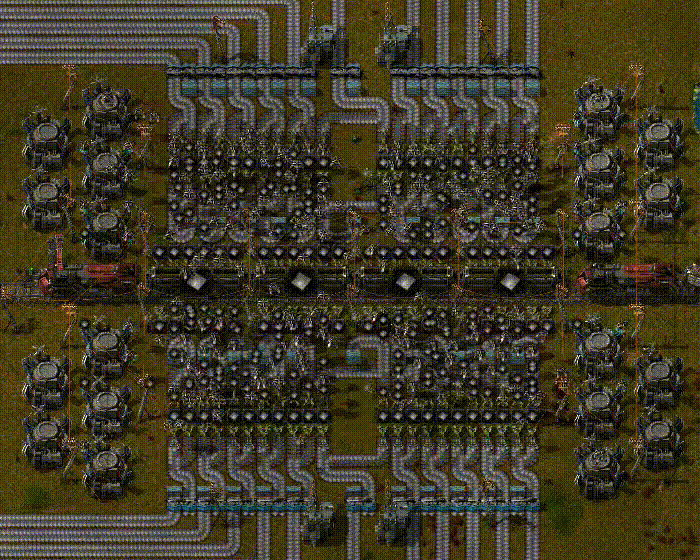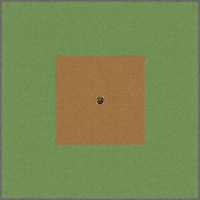Logistic network: Difference between revisions
(0.16) |
(Added blueprint string for example image of logistic robot train station) |
||
| Line 1: | Line 1: | ||
{{Languages}} | {{Languages}} | ||
[[File:RoboTrainStation.gif|thumb|700x560px|right|''This gif shows how robots can load or unload chests in a train station. The train delivers items that are filled into [[active provider chest]]s and then put into the [[requester chest]]s to be loaded onto belts.'' Logistics robots are ideal in train stations, since very high item throughput on a short distance is needed.]] | [[File:RoboTrainStation.gif|thumb|700x560px|right|''This gif shows how robots can load or unload chests in a train station. The train delivers items that are filled into [[active provider chest]]s and then put into the [[requester chest]]s to be loaded onto belts.'' Logistics robots are ideal in train stations, since very high item throughput on a short distance is needed. {{BlueprintString|bp-string0eNqtXdtuW0cS/Bc+i8GZ+4x/IkDyuAgWlkN4iZUlrUQZCQL/+1K+0LR1mlNdpSfbsljdUz2Xc2q6m/9srm+edvcP+9vD5s0/m/27u9vHzZt//bN53L+/fXvz/LPD3/e7zZvN/rD7sLna3L798Pyvw8Pb/e328XB3v/l0tdnf/rn7a/MmfLqafvD4uZuzj0TkI3fXd/d3D4ezj6XVj33cPxyejj85ffLLb2x/Pftk/vTH1WZ3e9gf9rsvI/38j7//ffv04Xr3cBzE6dO7v+4fdo+P2+NYbx+fHdhe724OR/T7u8fjx+9un00fIbch/VKuNn8//638Uj49+/YTaCRAwww0+UHHDDP7McsMs/gxp4RWgtAZZnNjLjPI7oaMM8jhhswzyLC4MfsU07+OwpTO4F9HYUpoeLmOHu9v9ofD8T9XZlH+ipYNNGIFhe8RSgbqyzX0dNzPHt4/3B3/BPalZ9yrb/vk3dPh/ul5O31pp7q4iBMuGsFFnHLRKS6Cm4vh4mK5zEVcCC6WGRcxMFwMLxWROL/q1HfXuqsTejNDRHETUTw+T7aKSBxi050iNoYI90YRu4eIyT4R/WfadrpNpIXaJrxEJGYFLm4r0UH3ZCdKxHPjdCNKzPqLbho8y28y6ZJ/9YUpC/4DL00xPSttsuOkQUQpe6OU/Uddm7GQg4OFfpmFHAkWupsF/zIbUxayg4XZE0lmnimDe+vKxDqbLrTcPERMdoLMPFAG9+aVx0tFY+UAal9Rw+qr9CK9XYTPnv65f9i9+/Ibcc1GkGxEQwSIkq4Sf/a8rtlIko1geJ6ltxiLjyJJQhgfVfIcmy1NGofFeZfelizOh4QK8VEXRZWDwlqDYsJgvEqveAbhNSlyIkZGVvzGQlqUUVh8Sy9/Ft9NkVoxvrviN8b3UEZh8N0W5R3T4LsFRYaG+G5R8RviuyVlFBbfWXnLtPguCihGRhVuASwulJsFbJZ04WUW42UIVxkGL30RvDamSA+CnxDXPQov+RDXPQl3PBbXWfDa4roIfmJcV+FmymKiCfKExUQXMLE5MQQmIK7HIggWBi8jCJgQLyMq94zGFBlJAcXYzoosglFTFBNWRKtyBYtR0xQTVkg7oL6Eckl8GZCA83wl94wx1m/aNQFnsS7wtawVE/b74no8vH333+3+9nH3YFyAnuDGz0HOq9jJgZ2d2JpkY9KhaTYmbHUwEZxMNAd2dGJrIo1Jx1DkDQv1LMdlSsTw8XCW6jLneHFin63Ap+sj/OfffYnbL206ISkaicmolCtmohaczOLk0rHOqhPascyc+2SQBBeTZkljsVCjY5E5t/ToWWROaMcp59wiY1LUG5PmrAg2Jqokrpio+KJzbo1RUVVMdzs+F7z+DkHtsPxNiyB3mKD4WnOuh4QvNeciTopmYhKhiCYmKH7COffIhK815yF0lthy6TGkXnoKSYpGYpKpyCIWaMaPse7jMeMrqzmRHSvLuXFJmSwmx1mRWExUfG05H/K1NBbTX0nqMFHxQ8z7zneWxDKFdu7gZ7ktFxSacWmLOUtdud6/3+5ujgYf9u+293c3u7Unra/pcm0dLHrydQyM70vn5u79/vFwdObdf3aPh+3D7n9Pxz8ncke3ygEyI540C61QXqapl5WRj0wvG+VlnHrZGYnE9HJQXoaZl3VhRCLLy7MUEoeXY+pkpAa/THETo7CYg8+EFGSCMXqFCVYZ/sqUPmrl1ClsJ/QUc+iDUFAssLNkD8eAp7tuo1bNdJtskVBNzKFTJ850k2yZkF9MH7nzZupjJXQc00dmzUw3srM8DcfI57CDUC2skffFr9iYWMyKmU7Gzhwz0+nTk1+bMMed/QqKicWslule1pmjZrqV9eZXIMxxd79OYmIxT2V9NtrBHDNtihr86oM17hH9eoOJxZws82e7s0QIHHb6JDoKIYeYI69+VcHEYs6V+evBYA6W+bvRGISS0KwK6IXQDkyw4MjnaOsQ0aMWxHgRK3lyQ4whSa0DKiKyRCqF4WSjYDaqkowCjqMpNgqShhSp/IboHMdQUkowG2FRxoHFPARlHFg8QlTyTUCulKY6oImsDAMMRxGGAUajCkklIFNNMAES1YUkFnAUQzCBxYJpLuI8OGIQTGCxYLqMOI8NJh/DeWowyRnOQ4PJ1HDu51FpsAWOogkmwFh0IaUFHMXgs1AwC0SKx9Z5XKTADwKLRIp8ngpIU+LTa0ALmR8DyFLhxwBGuvIZLaAFoQcKGIfOp/qAFoQme1iklR4pWBxy4DNjMJZy5McAWkj8GMA4KGkooInCp8+ANFXeAjiZmkATOIgupMKAJoaQw4MRRTRoCc5DgujP4lUMoNSXb6k462JWSZ7smbSOkbWul/m8Mc/+1uzpJ2liGWO0KjYSUu4Xi6SJWf0Ei9huEw3CUEQqLAhVEsKwIFRJCLOCUKPU5xOMAdOu5fs2D8ZAUr/AGCjqlxkCRe8CuVH0LpAaRe8yqRlS81VwdjZF5MIC0BSRCwtAi1J/VpQrRecyO8sqyhYYAEXZAgNQpb6waAAUccsMgCJngewMwQQWY6LryzJjpktdeMGYEo1fgo99ovFLnFKTea/BgBal9y9KfuUlGZMaQaoCqem8BXDKSC19QfKHoFZhRI2g9ORFhxF5OcmaQ0SrmOaLMNEpZjgtCAoVGN4q6Ecm9U1qYIxOGq07MGpFkaagGCSi9UzwnV+JaEMTZgdYWqIj0yutQ6Qfvn9q+/Wbo1aeJb+X72IDzmvfiLWC+zV5LP6k711tvtXSvtn8dhzc4dfP7aN///rDVZOFKaoK2BSpTFkZiG0mPr49fuzjbnv/cPdx/+fEVrQmSRfQ0xR9MMVXGC+exjRntZ8YdhBYiTNWQhTQwxQ9EVVaIC2ZKScDsYtAyjIlpfLoYwruaGLTnKwIy7NN/R5ECR7mt6ehTXVCC2uzziiJwtIsU/BElOqBpGSiFA6EFhbm9PiJwrqcnj6xEXVtICnCupyeD3H4C8kwt9NC1LuB0MKynG7fiV+Wc+zkLzkDKcn+wjgQmV+T0+eHxC/J6cxOzV+aBjLS/QV0IPKg+ZjuUHmhsadbq6NljvMEzvxqnB7AOfmL+ECvs7+kD0TmV+P0GS3zq7FPsRtR6wdS0v2VfyAyvxynD/KFX47zV5ASiCo+jJPCL8j5+2QBNaAL79irEtAPrXiOyO//c9h+/pJzs9/QgqAWHDXiqBVHXXDUBqOGjqN2HLXiqANHxaP1Q3OeCSoerRpwVDxaNcKoeLB+aNBzGRSPVcVXliNUjoWFg8LryhEneFU5/ITXlINQeEXhkW/wesKnaINXk2MxNXgxOdZ9gxeTY4tq8GJy7KZn6TrzJN/1q5nGXDkE6+t3G3E3YoK9xpWC9TTSxivchljgnblSsGjogbj7MMFe48rAHHZ6hdsOE5y5MzBpKP67DRPrFa4EzEG3V7jMMMG7/7rBJGHo9wuWn4O4A7D8dPT2OenwJtYraPzmmJN+OWFiExq/yUHxX0WYWK+g4Ztjbvrlg4nd/dcDJgdDvw8w/MwLIdoHCyu4rxZMKF2TN0ec9LsEE9svypsMFPfNgQmli+7mgJt8V2BC+0V3k4DhvhmwoIIuqlsDFvJC0gw6uuV6k4Ak6/Oml34R3fSyuJV+E0oXyc0BN1nbN6H9GrlJwPAr+RZWfAUR3BqykLsxZtDRL6+bFCRdTzf9zHhWZlpHKI6WeYYTXC3Pt+3xZd7sPFM3U21rvllMyD1IZtrWnBSHhBSR5zgEE9mYEyudapBwRCUcKQg1vVg4UhRKerFwpCSYMMPBlc8vUjiE0ltzHJXHBOlvQlEyOIk6X9sLWhD6zGE0EU1rThas4Gam8OfEDDVHs9BnDiQq8XXEWLCJvjXb2fadmTq+rXSYEp1rtr7NOwuFuGCwO2/BDAVVUS8dpIUvy7VGQXSq2fp21RJpp7HglsQEQjpCC99mDhxToQ2YkWYexIPEUqPLmsGpxZfuggb4JnNWGIgGN9k1dSpzWiclzlTnmyZZ5Ct6scATLXD6LPCFhgQDzyzwIYWh0UXJYBg6X5NsxmHwmFggGvOOHaSttgkN57BQtMjXDYO0Jd6CFeyW8S55BkJhvq+yrWNVRy6OAaE0kCsWS4qYVS3QIYhwBcnrzX0RTFh+d6U7nMVwV/Qp09Mk6Gogw1kwYfpdBCkH9LsKJky/Gy9ymROj85imn4LKZGES7WVOChAWshF4ry12iW4yJ69NJgThCGQi8xZMrwsvRpnsVh7T9FPQgkxMQf0xxz54VczwsxDdX7au7bwsgtoDWoi8BZOXRCtIJmSmIYsFyX8xgOllpSHBaDVaZjJp6DSkSQOvwliQgVdhrIETX6+VXMEivlsrzWjgdRTQ50wbMH3mdRQzdJWGNL3kpRGQ2U4bMH0WlBGLWuJrr2bP4SUKYoeJGXlMLGBRkDdMdjOPaTJR8Kyhto5QiS/tNKCaIwFprENQ3+d9kje6RdOgYPME1tM25QTWEAWvpEBUXoHQkShAAqETUSgFQmcqhGEWwkLBxhls9RckgTw0om4KhKYW35hRwa29ZQJ7ljvz+HT9reujVXO9vtvkwLhWZp5FBrXOUJO/0gkLu6MByslLEJlaXLNd1259cgl1dkQ4mp5sfVu5o+fJ1reTZ25pTZiwu51cQp3tiI42J1vfyVA855kPOTFMzHauwpxkU9DiLuACOaj+KjMQuRE8TCcvc4ZN5+5w14ZhFNTFXSkGAjMn22yLrMzBNtvNa3LXioEUZHflGAhcoCePeuHBozJHWJ8xyaynNgPt7sIukMXhLvPCgBtzfE0fNxuzoGaPxi26K71ADpK/7gtEZg6v6VtYYx4Upy9hjlYozpdRR18U5xv0WXbHNAdmfW85S+WY562EsIpB5WqcSnkXaKRU6kZ22oiEijKM6dQTofaYYFnIMUFHX4R8ENRGJcQkk5RGyEcmmJCsgQ5+CIkroA1Pt5QxocTTLeXkpwkmpGugY098lglqghA/TEaKX6IxsSqfVoIOvfEZIaiJ7hdVTEaGX0YxsKqSvIENvTLZG8FpIvolFZOR5BdRTKzslwxMLL+uYUJVPtsFjUijM1VQC53OMkEt+MUOi/HglzdMqEBnqoDjJjI2stNConNCUAvZLaaYhBe3fGJCVbeGYEI1t2pgQnU62wWNxqAzVUALjq/TmTwb1hj8koGJFel0F3Tgic9UQU1kv3pgElL8eoGJVfnkF3Tojc9UQU10PHFlXaSoUsuVZ38BN5NStPLSRly1IQkhARtHVLgKSElYTUqFC8qVJJuA4yiKDXBeVYUrMOZKExY0HorIAoZjCCawaDB9WL4zhUUjB0EuwYLB9GEpTqYURQaLN9OJpTpjIdTXoKNQ9BtwFE0wAc6oLhAFzqgh6CSYibIIJrBwM51ZnEcf0Zpl6zwxShIUEtAEX8uDhqIIgwBDUflBgFOW78aCBkIQkkCWBi/ZYCwR7VmibzJVvk4IZKnyhUJgpIn+K9nJUuYtgJEuvFgDslR5C2CkGy8HgXHovAUwDoNXdrA4tIW3gMWBab/iPIOY/ivOE4JpwOI8IloWTICxKILSBBJVBRNguF+u7Mf7m/3Byg35gp0x97vUkjkku0PR3dPBaFFUm6StQU2K6kqS0SXWooc1qS8M6n+UujOTkVnpI3OJtcXFWhakFpC0IvVQZkmrgmwBDqwpfXfZcXXPZKiuuTCEV3+MsrEo/XFJylY611ygzLVVMxlRzj1nJKWPLUtZ9lDm2qdHUdrBsuOpjvG4NtAh5H+AE6ALjWFZvoaDL0/42yK8wCfMgtJgleOrrbTVsfnKLr6EV3mQryy0h2X5Kg6+uosvvlcIylcT+riyfHlOfdcTYFuEriIgY0FquEpSFjynvutVowWh1ypKWVIyBApmQ2keidpQekmiNqpwfQiaUC7eQBNduOwBTQzhngQzwfQTcloQ9HnQQuR1YdBC4hVP0IIi5K2Y+ONqsz/sPjy3DLp52t0/7G+fEW7eHqGOP/vt7vru8Ovnvfj3U3Hsx93D4xcBrR+D1lNdUv706f83nKLi}}]] | ||
A [[Logistic network]] is a series of different logistics chests and [[Logistic robot]]s all covered by one or more connected [[Roboport]]s. | A [[Logistic network]] is a series of different logistics chests and [[Logistic robot]]s all covered by one or more connected [[Roboport]]s. | ||
Revision as of 19:40, 24 May 2018

A Logistic network is a series of different logistics chests and Logistic robots all covered by one or more connected Roboports.
Depending on the type and configuration of the chests and area of the Robotic network the robots will transport items between these chests as a power-hungry alternative to moving items manually, or by belts or Railway. However, robots offer much higher mobility, since they can fly over obstacles in a beeline.
The player character can also act as Requester chest in the Logistic network, allowing them to 'request' various items be kept at a set limit within their personal inventory. After researching Character logistic slots, they can configure an amount of items; and Logistic robots will start to move the specified items from the network to the character's inventory.
Do not mix up logistics network and circuit network. They share common components, but are otherwise disconnected and do not exchange any information. Also, do not mix up logistic network with construction network or combinations of the two called Robotic network.
Achievements

|
You've got a package Supply the player by logistic robot. |

|
Delivery service Supply the player with 10k items delivered by logistic robots. |

|
Logistic network embargo Win the game without building any active provider, buffer or requester chests. |
Items
| Entity | Description |
|---|---|
| Roboport | Center of the robotic network in which the Robots operate. Roboport coverage defines the area of the logistic network. Robots need to periodically return here to recharge. |
| Logistic robot | Moves items between logistic chests.1 |
| Active provider chest | Logistic chest: Pushes stored items into the logistic network.2 |
| Passive provider chest | Logistic chest: Places stored items at the logistic network's disposal.2 |
| Storage chest | Logistic chest: Stores items currently not requested. Can be filtered to only store one type of item. Supplies stored items to the Logistic network.2 |
| Requester chest | Logistic chest: Will be filled by logistic robots until the configured amount is reached, or the chest becomes full. Can request multiple different types of items.2 |
| Buffer chest | Logistic chest: Functions as both a requester chest and passive provider chest.2 |
(1) Default capacity is 1 item per robot. This can be increased by researching Worker robot cargo size (research).
(2) Logistic chests can also be connected to the Circuit network with red wire or green wire.
Usage
To start with, just use passive provider- and requester chests. Place the passive provider chests at the output inserters of assembling machines and requester chests at the input (let them request the needed items). Place a roboport, which covers these chests with the inner orange area. Place some logistic bots in the roboport. The robots will fly out of the top hatch and will begin to work. You can now limit the number of produced item with the stack limitation-feature.
The logistic network is makes it possible to create complex items in a relatively small factory area, but its throughput is limited by how many robot charge points (roboports) exist in the network.
The basic thing needed for item transportation is roboports. The roboport shows the orange logistic coverage and the green construction coverage when held in the cursor or hovered after placing.
- The orange zone is the logistic network coverage. This is also the maximum distance for connecting two roboports.
- The green zone is the construction area.
- For more info on the specifics of how roboports work, check the page dedicated to them.
Expanding the logistic zone
There can be many separate logistic networks. Two roboports are in the same network only if they are connected, so if their logistic areas are touching. Visually this is represented by a dashed yellow line connecting them. To prevent roboports from linking, the player needs to build them far enough away from each other so that the orange zones don't touch.
Bots do not fly migrate from one network to another, unless their home network is destroyed in some way, for example when all roboports are removed or out of power.
Losing bots
Logistics robots are a priority target of biters, and the enemies will prioritize attacking them over many objects in the vicinity of the robots.
Bots are not destroyed when running out of energy, but will be reduced to 20% of their speed, which allows them to slowly fly to the next recharge point.
Robots may run out of charge on longer journeys. When the charging-queue for the bots gets too long, the bots (and their loads) will slow down. Generally, a roboport can charge between 50 and 70 bots per min, 4 at a time, but are not very efficient at charging large queues of bots and can quickly become overworked. Place more roboports near the first one to share the load.
Negative numbers
It is possible to notice negative numbers on the 'Logistic Network'-Screen when looking at network storage or opening the logistic networks GUI the with L.
The logistic network numbers report items in provider and storage chests, minus the amount of items scheduled to be picked up by robots. When negative numbers are shown, it means that more items are being requested than are available in the network. There is a deficit. This can be a problem, or intended, depending on the player's choice. The negative value is just to explain why items aren't being delivered. For example, a deficit of 20 iron plates would look like this:
Receiving more items than requested
The delivered number of items in the requester chest can be higher than requested. This depends on the researched Worker robot cargo size-bonus, since bots will always take as much as they can carry if an unlimited amount is available.
Priorities of robots
This overview reflects the priorities in which order the chests are filled/emptied.
Logistic robots on the logistic network looks for orders by the chests in this order:
- A requested item is first looked up in the active provider chests, then in buffer chests, then in the storage chests, then the passive provider chests. So, the active provider chests are emptied first, then the buffer chests, then the storage chests, then the passive provider chests.
- If robots are free and there is space left in storage chests, and there are unrequested items in an active provider chests, the items are moved from active provider to a storage chest that has the filter set to that item type. If there is no storage chest filtered to that item type the item will just be moved into any free storage chest without an item filter.
- For the storage chests, the bots search for one storage which has its filter set to the item type, then for one that already stores items of the same type. If that can't be found, they choose the first storage chest with a free slot from the list, which is sorted by the order they were built in. [1] This is to avoid having storage chests with different items inside, allowing greater organisation.
Storage chests will be filled with items from active provider chests, and from robots that have had their orders cancelled while they were carrying items.
Order of movement
The bots fulfill all requests with the same priority. The algorithm looks for the next free robot, then the next request in the queue and after giving orders to the robot, this request is put at the end of the queue, so that first all other requests are done.
Distance
When looking to pick up requested items from multiple chests of equal priority, bots will always choose the closest one. [2] This is however only true when an item is being requested, not when an item is sent away. [3] In the case of items being sent into the logistics network distance does not matter, and the rules laid out above matter instead.
